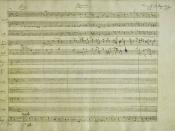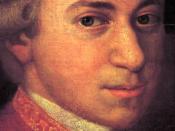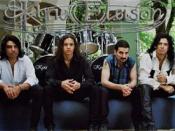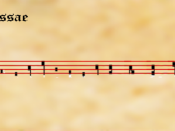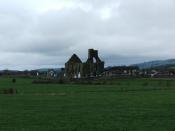Mozart's Requiem, in d minor K 626, was written in 1791. Franz Sussmayr, who was Mozart's understudy, completed it. About half of the Requiem is credited to him, however analyzer's today and of his day question whether he really did complete any of it due to the mastery of the piece.
During Mozart's illness, a stranger visited him. This man (who kept his appearance concealed) wanted him to compose a mass for the dead. He was obsessed at this point that he was writing his own Requiem and so although he was ill, he completed parts of it and a basic outline, of which he discussed with his understudy Franz Sussmayr. He "made Sussmayr familiar with his further plans for the work, showed him the outlines of the unfinished movements and explained how they should be completed."�(1) Seven weeks after his death it was finally finished. It was then discovered that the man who came to Mozart was Count Franz Von Walsegg. He wanted a requiem written for his wife's funeral. He also desired to pass it off as his own, which is why he kept hidden from Mozart. Because nobody defended Mozart right away, the Count was able to take credit for it and rename it as his own. It wasn't until 1799 when it was first published that Constanze revealed the truth that Mozart did not finish it and that it was not written or completed by the Count.
I f we take a look at the Kyrie (in the beginning) and the Cum Sanctis Tuis (the last part) you will notice that the form, and notation are exactly the same. Before Mozart passed away, he fully orchestrated and completed this part of the mass. Susssmayr, who was given the task to "fill in the unfinished parts"�, decided to repeat the Kyrie part with different text. Because this part of the mass is the communion and confirmation part, Sussmayr felt that there would be a connection with the beginning, the confirmation and forgiving part.
Kyrie eleison, Christe eleison, Kyrie eleison translates to Lord have mercy upon us, Christ have mercy upon us, Lord have Mercy upon us. In this part of the mass the congregation is asking God to forgive them and at the same time the people are praising God. It is a rejoice-full part of the mass and a sorrowful time, thus implying a brighter sense of music, a major key signature, and then perhaps a modulation to a more minor sounding key.
The different keys are tied in all together by way of the fugue. A fugue in this case is "a contrapuntal composition in [four] voices, based on a subject (theme) that is introduced at the beginning [through] imitation and recurs frequently in the course of the composition."�(2) The subject in this case would include the first three and a-half-measures of the piece, as written for the bass line. The line starts on a dotted quarter note (A) and continues for the three and a half more measures until the "E"� quarter note. Although phrases do help to distinguish the different parts of a piece of music, in this case they may not. As you see, the subject ends in the middle of the second word "eleison"� on the second time. The counter subject usually will end at the end of the subject, however it begins in the alto line on the "E"� quarter note and continues for two and a half measures where it ends on the "G"� quarter note. Just like the subject, the phrase is not totally complete. The counter subject ends in the middle of the word "eleison"�, but the phrase starts off with the second part of the mass's text "Christe"�. By entering the counter subject fairly close to the subject with the different text, he makes the reader aware that these phrases might be of equal importance despite the fact that one phrase begins sooner than the other. The longer stronger tones of the Subject as compared to the short running sixteenth notes in the counter subject may also be to emphasize that the beginning phrase has slightly more importance. It could even just be because the text as a whole starts off with "Kyrie"� that it has to be slightly more important.
After the subject and counter subject are completely displayed what is called a tonal answer is portrayed. A tonal answer is "The subject (of a fugue) transposed usually to the perfect fifth above or the perfect fourth below. However, slight modifications are made in a tonal answer so that the intervallic distance is not always the same as in the subject. The modifications generally entail replacing dominant implications with tonic. Thus if a fugue subject begins on a dominant tone the answer begins on the tonic."�(3)The answer in this case starts on the tonic (D). This occurs in the soprano line, in the middle of the fourth measure.
As we continue on, another counter subject (to play off of the new subject) occurs in the tenor line, five measures in on a "B natural"�. At rehearsal letter F another tonal answer occurs in the alto line this time, starting on an "A"�. The counter subject to this enters in the bass line one measure later. This one begins on "E"�. Finally, the subject appears in the Tenor line, four measures after F, with its counter subject entering in the soprano two half measures later. Once the presentation of the subject is completed in all four parts (as with the counter subject) the end of the first section, called the exposition, is completed. The exposition begins in "d"� minor and works its way to it's dominant minor "a"� minor at the beginning of the first episode.
An episode is "A short interlude in the development section of a fugue that does not contain the subject or answer but connects entrances of either in various keys."�(4) The first episode is briefly done in "a"� minor, and continues for one and a half measures where the beginning of the development occurs, with entry I in "C"� major.
The development begins with the first entry in the soprano line on "C"�, followed by it's counter subject one measure later in the bass on "C"� also. They end at rehearsal H where entry two comes in. Once again the subject enters in a different voice"æthe Tenor, followed by the counter subject in the soprano. Entry three starts in the bass three and a half measures later, followed by the altos having the counter subject.
Once this run is completed another episode occurs at two measures after rehearsal I. This time it lasts only one brief measure modulating to "Bb (flat)"� major. Another entry happens in the soprano and counter subject in the tenor, followed by still another entry in the bass line and its counter subject in the alto once again.
After this section is complete another modulation occurs heading to "f"� minor. One and a half measures after rehearsal K starting with the altos this time and their counter subject is projected in the bass.
At about four measures after K we modulate to "G"� major where counter subjects are shown as a stretto starting in the tenor, then passed to the altos, to the sopranos, and finally the bass's. A stretto is the "overlapping of subjects (or answers) in different voices. A subject in one voice is not completed before the same subject is introduced in another voice."�(5) Three more modulations take place as we continue onward to the end. "d"� minor at around three measures after rehearsal M, to "A"� major two after N and finally ending in "d"� minor in the coda (extra material at the end of a piece in which may bring the work to an end. It is not necessary to be done horizontally, but may be done by chord progressions to make a piece conclusive). The coda is perfectly pointed out by the fermatted rest in the third measure from the end. There is a clear distinction that at the adagio when everyone is singing chordally that he wants this to be the end. As you can also tell he wants this part to be loud and strong, however you will notice that there are no dynamics involved.
In fact, in the entire piece he does not make one reference to dynamics. Mozart almost never included dynamics in any of his works. He felt that according to the text and register of voices, as well as how many parts where playing at once, and what sort of instruments were playing, that one would be able to interpret how it should be performed on just that.
Using the fugue to make apiece go from soft or not too loud to strong, powerful and loud is a great way to build tension or a sense of power.
Let's take a quick look at proportions. The entire piece is fifty-two measures long. Fourteen measures from the beginning inward is the measure before the first episode. With proportion to the last fourteen measures from the last one in is where the original key returns. Twelve more measure in from both of these points happens to be where the second episode occurs, which is also midpoint of the piece.
The time signature is an allegro four four time. The notes start off as a doted quarter note which is a slower feel, but eventually becomes running sixteenth notes, which give the performance the quicker feel it needs to carry on without being too repetitive. The sixteenth notes run in a constant upward flow, which could make it difficult to execute without slurring everything together. Mozart is careful not to have these sections alone in the piece.
A strong "kuh" sound at the beginning of the words Kyrie and Christe help to give the parts a secure start so that they rest of the line may be continued without dying out.
Clear cut endings are also important in this piece. As you notice the subjects and counter subjects in the development end at the same time to prepare and support the "next"� entry.
The end of this piece sets up for the next one with the same ending notes as the beginning ones in the next, which may be the reason for a very basic coda.
